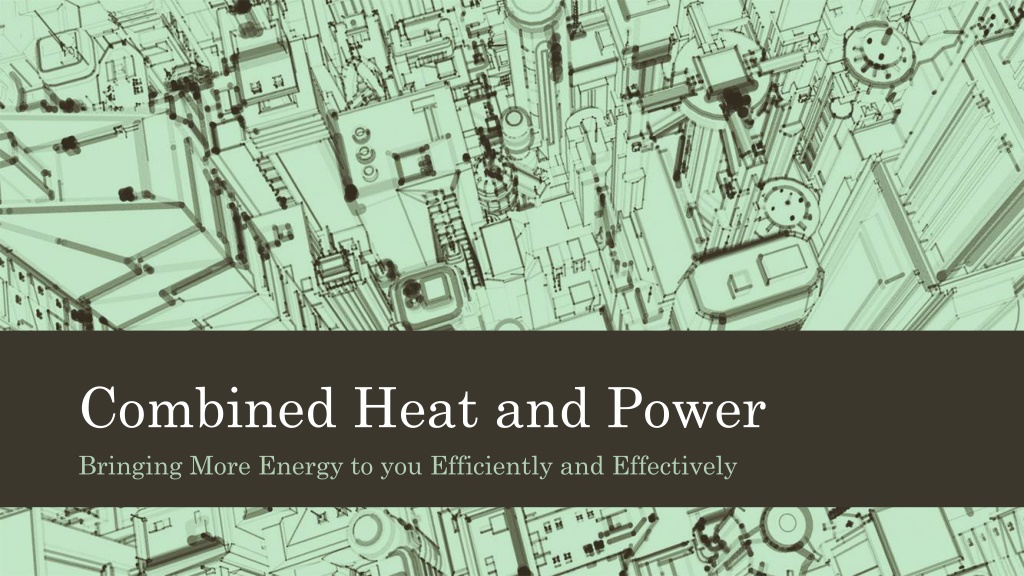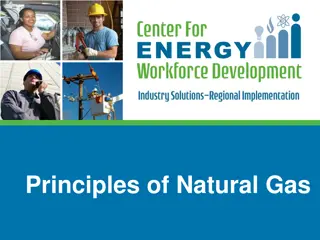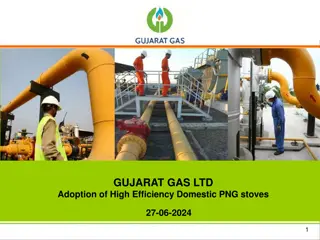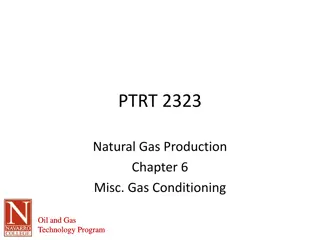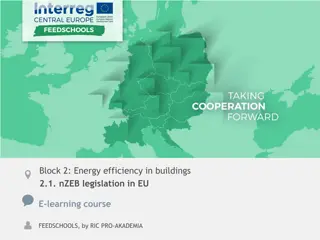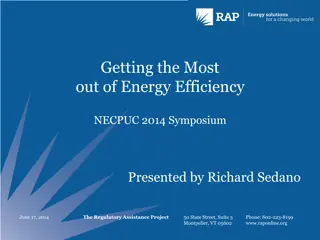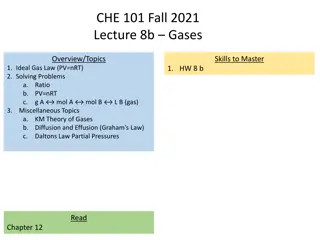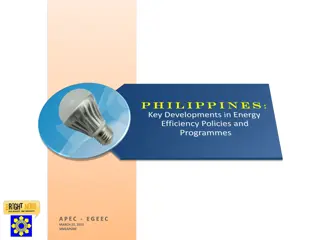Energy Efficiency and Natural Gas: A Comprehensive Overview
Explore how combined heat and power systems, Marcellus and Utica shale formations, affordable gas options, and the benefits of electricity from natural gas are shaping the energy landscape. Discover the potential cost factors and considerations for subsidizing CHP installations using modeling techniques.
Download Presentation

Please find below an Image/Link to download the presentation.
The content on the website is provided AS IS for your information and personal use only. It may not be sold, licensed, or shared on other websites without obtaining consent from the author. Download presentation by click this link. If you encounter any issues during the download, it is possible that the publisher has removed the file from their server.
E N D
Presentation Transcript
Combined Heat and Power Bringing More Energy to you Efficiently and Effectively
Marcellus and Utica Shale Marcellus Shale Formation 104,000 square miles, largest source of natural gas in U.S. Hydraulic fracturing required to reach the natural gas, divisive topic Utica Shale Formation size and gas reserves currently unknown Significant amounts of natural gas available for years to come
Affordable Gas for the Region Low cost energy brings business to Western PA Shell s new Ethane Cracker plant in Beaver County PA Peoples Gas hopes more business will come to the region with even more affordable energy options
The Benefits of Providing Electricity with Natural Gas 50% of electricity transported via electrical grids is lost After initiatives to replace aging natural gas piping, natural gas leakage rate is well under 1% Distribution infrastructure buried underground, mostly immune from weather based disasters In the event of a natural disaster that negates electrical grid heat and electricity still provided to consumer
Costs in the table are for the steam turbine alone ~$500k to ~$10M Full installation of entire system could be as much as $5,000 per kW production capacity Total cost $2.5M to $75M depending on system Cost of CHP Installation
Modeling CHP Using SuperDecisions to model Subsidization Program
The Question Subsidize CHP Installation ? Significant cost to implement CHP systems Ideals Normals Raw Alternative Full Sub 1 .723545 .534863 Balance desire to convince customers to adopt systems with taking on too much cost Partial Sub .357662 .258784 .191300 More cost subsidization means more customers willing to adopt the CHP system No Sub .024422 .017670 .013062
Strategic Criteria 1.20 Benefits Costs Opportunities Risks 1.00 1.00 0.80 0.75 .63 0.59 0.60 0.40 .26 0.25 0.25 0.16 0.20 .10 0.00 0.00 0.00 0.00 Growth Synergy Reputation Growth Growth Reputation Innovation Growth Reputation
Benefits Growth Subnetworks Financial Market Share Revenue increase due to larger customer base Growth means a larger more diverse customer base Expenses increase as well, lowering taxable base Increased share of gas and electric utility markets Most expense increases will be capital expenditures with long amortization periods More gas distributed = more distribution revenue
Benefits Synergies Subnetworks Workforce Piping Network Increased knowledge base for employees Utilize one piping network to provide more than one type of energy Can utilize similarly sized workforce to do more Energy conservation More revenue compared to rent expense
Benefits Reputation Subnetworks Community Markets Environmental impact, less energy lost Make new contacts related to CHP in natural gas markets Single source supplier means strong relationship with customers Make new contacts related to CHP in electricity distribution markets
Costs Growth Subnetworks Financial Market Expanding operating employee base (different from support employee base) Success may bring new competition into the markets Extreme market growth may cause ownership to divest Increased insurance liabilities
Opportunities Growth Subnetworks Financial Market Revenue growth Expand overall market share Overhead such as service employee labor costs can be spread across a larger base More brand and name recognition Value creation
Opportunities Reputation Subnetworks Sector Social Responsibility Considered impact of this decision amongst the 3 sectors of energy customers, industrial, commercial, residential Chance to expand upon charitable activities and events with larger presence Show goodwill if subsidizing product costs
Opportunities Innovation Subnetworks CHP Technology Pipe Technology Large power conversion technologies (gas and steam turbines) Further improve upon on energy lost in percentage of energy lost in transmission Smaller power conversion technologies (ignition systems, fuel cells) More energy transmitted underground out of the elements Protection programs for these systems
Risks Growth Subnetworks Training and Product Development Expanding too quickly could lead to improper training of staff Participating in installation of CHP systems could lead to poorer quality due to inexperience Could infringe on established patents
Risks Reputation Subnetworks Monopoly Intentions Residential backlash Less focus on social responsibility initiatives Industrial/commercial backlash Even larger presence in the lives of customers Regulator backlash
Other Results Additive (Negative) Formula Multiplicative Formula
Conclusions Subsidizing all costs clearly outperforms the alternatives Large upfront capital outlays will payoff in the longer term Expands customer base Improves relationships with customers by showing goodwill Less customers will be willing to participate in program at partial and no subsidization alternatives May have under quantified the costs and risks of fully subsidizing option
References 1) Facilities and Campus Services. Combined Heat and Power Plant, energyandsustainability.fs.cornell.edu/util/heating/production/cep.cfm. 2) What's An Ethane Cracker? NPR, NPR, stateimpact.npr.org/pennsylvania/tag/ethane-cracker/. 3) Utica Shale - The Natural Gas Giant Below the Marcellus? Geology, geology.com/articles/utica- shale/. 4) https://www.energy.gov/sites/prod/files/2016/09/f33/CHP-Steam%20Turbine.pdf 5) Combined Heat and Power (CHP) . Combined Heat and Power (CHP) | WBDG Whole Building Design Guide, 8 Mar. 2016, www.wbdg.org/resources/combined-heat-and-power-chp
